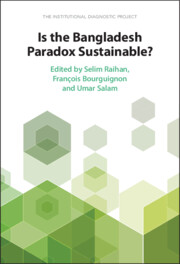Book contents
- Is the Bangladesh Paradox Sustainable?
- Institutional Diagnostic Project
- Is the Bangladesh Paradox Sustainable?
- Copyright page
- Contents
- Figures
- Tables
- Boxes
- Notes on Contributors
- Preface
- Acknowledgements
- Institutional Diagnostic Project
- 1 An Institutional Diagnostic of Bangladesh
- Part I The Economic and Institutional Background of Bangladesh’s Development
- Part II Six Challenging Institutional Areas
- Part III An Institutional Diagnostic of Bangladesh
- References
- Index
- References
References
Published online by Cambridge University Press: 10 January 2024
- Is the Bangladesh Paradox Sustainable?
- Institutional Diagnostic Project
- Is the Bangladesh Paradox Sustainable?
- Copyright page
- Contents
- Figures
- Tables
- Boxes
- Notes on Contributors
- Preface
- Acknowledgements
- Institutional Diagnostic Project
- 1 An Institutional Diagnostic of Bangladesh
- Part I The Economic and Institutional Background of Bangladesh’s Development
- Part II Six Challenging Institutional Areas
- Part III An Institutional Diagnostic of Bangladesh
- References
- Index
- References
Summary
- Type
- Chapter
- Information
- Is the Bangladesh Paradox Sustainable?The Institutional Diagnostic Project, pp. 383 - 408Publisher: Cambridge University PressPrint publication year: 2024
- Creative Commons
- This content is Open Access and distributed under the terms of the Creative Commons Attribution licence CC-BY-NC-SA 4.0 https://creativecommons.org/cclicenses/



